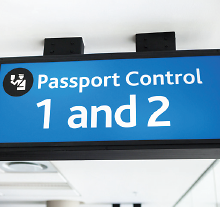Dopamine Appears to Be Elevated in Immigrants, Their Children
A new study appearing in Schizophrenia Bulletin provides a biological basis to explain why immigrants have an increased risk of developing schizophrenia.
This effort, led by researchers at the Centre for Addiction and Mental Health in Toronto and King’s College London, found higher levels of stress-induced dopamine in the brains of immigrants compared with nonimmigrants.
The two research groups carried out complementary case-control studies of in vivo dopamine function (stress-induced dopamine release and dopamine synthesis capacity) using positron emission tomography (PET). The Canadian study used an approach known as PHNO-PET to investigate whether the induction of stress (using the validated Montreal Imaging Stress Task) elicits more dopamine release in first- or second-generation immigrants compared with nonimmigrants (people who had been in Canada for at least three generations). The London group then sought to confirm any associations between immigrant status and dopamine levels using a technique known as DOPA-PET that estimates dopamine production.
Both the immigrant and nonimmigrant participants included people who were classified as clinically high risk for psychosis as well as healthy controls. Regardless of clinical risk status, the scans revealed that striatal stress-induced dopamine release and dopamine synthesis were significantly elevated in immigrants compared with nonimmigrants.
“The data from the present study identify a plausible biological mechanism that links the effects of migrant status to the risk of developing psychosis through elevated brain dopaminergic function,” the authors wrote. “These findings suggest that interventions designed to reduce the psychosocial impact of being a migrant might be useful as a means of reducing the risk of psychotic illness.”
Elevated-Striatal-Dopamine-Function-in-Immigrants
High-Dose Opioid Prescribing Dips After VA Launches Audit Program
High-dose opioid prescribing fell in VA clinics nationwide after the introduction of an “audit and feedback” initiative, according to a report in the journal Pain.
Rolled out by the Veterans Health Administration in October 2013, the Opioid Safety Initiative (OSI) aggregates data from electronic health records to audit real-time opioid-related prescribing. Each VA facility has a designated leader who compares prescribing practices at the facility with national and regional data and offers clinicians feedback on safer prescribing.
The study examined changes in outpatient opioid prescriptions across VA clinics nationwide between October 2012 and September 2014 (one year before and after the implementation of OSI).
During this time, there was a 16 percent reduction in the number of patients receiving a high opioid dosage regimen (total daily dosages greater than 100 morphine equivalents [MEQ]), going from 55,722 patients in 2012 to 46,780 in 2014.
Additional analysis revealed that OSI contributed to a decrease of 331 patients per month receiving doses greater than 100 MEQ, a decrease of 164 patients per month receiving doses greater than 200 MEQ, and a decrease of 781 patients per month receiving opioids and concurrent benzodiazepines.
“These results highlight the importance of addressing provider behaviors in our efforts to address the opioid epidemic, and the need for large health systems to develop and implement systematic approaches that are flexible enough to allow clinicians to make individual decisions while still reducing the overall prevalence of potentially risky prescribing,” senior author Mark Ilgen, Ph.D., of the University of Michigan Medical School said in a press release.
Deep Brain Stimulation May Impair Some Memories
It has been suggested that neuromodulation may be able to help patients experiencing disorders of learning and memory. A study in Neuron now suggests that deep brain stimulation (DBS) may, in fact, impair some memories.
The study, conducted by researchers at Columbia University, involved patients with epilepsy who had DBS electrodes implanted to determine the location in the brain where seizures were originating. Participants were asked to perform two tasks: a spatial task that involved remembering the location of an object in a virtual environment and a verbal task of recalling a list of words.
The participants practiced these tasks under normal conditions and while receiving DBS to one of two regions linked with memory: the hippocampus or a part of the temporal lobe known as the entorhinal cortex.
Regardless of the task or location of stimulation, all patients performed worse on the memory tests following DBS compared with when they were not receiving the stimulation.
“Given the success of DBS in other areas, we were disappointed to find that our approach to entorhinal and hippocampal DBS did not improve memory performance,” the authors wrote. “Nonetheless, it may be possible to learn from our results to derive more effective stimulation protocols.” ■



